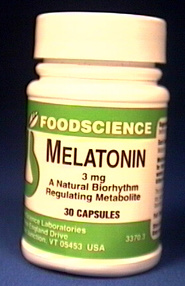
THE HUMAN CLOCK...page 2
Where is the Clock?
The clock in humans is located in the suprachiasmatic nucleus(SCN), a distinct
group of cells found within the
hypothalamus. The SCN is only one part of
the mechanism by which the "time" is kept.
There are light receptors found in the retina
which have a pathway, called the
retinohypothalamic tract, leading to the
SCN. The pineal gland is a pea-like
structure found behind the hypothalamus in humans. The pineal gland receives information
indirectly from the SCN[3]. It appears that the SCN takes the information on day length from the
retina, interprets it, and passes it on to the pineal gland, which secretes the
hormone melatonin in response to this message. Nighttime causes melatonin secretion to rise, while daylight
inhibits it[3]. Even when
light cues are absent, melatonin is still released in a cyclic manner; yet if the SCN is
destroyed, circadian rhythms disappear entirely[4].
The role of melatonin in humans is not clearly understood and is currently being
investigated,but it is thought to play a role in photoperiodism in seasonally breeding mammals. The SCN is known to have
hormone receptors for melatonin, so there may be a loop from the pineal back to the SCN.
Researchers now use melatonin levels as an accurate marker of the circadian rhythm in humans.
in humans is not clearly understood and is currently being
investigated,but it is thought to play a role in photoperiodism in seasonally breeding mammals. The SCN is known to have
hormone receptors for melatonin, so there may be a loop from the pineal back to the SCN.
Researchers now use melatonin levels as an accurate marker of the circadian rhythm in humans.

Accessibility statement
 in humans is not clearly understood and is currently being
investigated,but it is thought to play a role in photoperiodism in seasonally breeding mammals. The SCN is known to have
hormone receptors for melatonin, so there may be a loop from the pineal back to the SCN.
Researchers now use melatonin levels as an accurate marker of the circadian rhythm in humans.
in humans is not clearly understood and is currently being
investigated,but it is thought to play a role in photoperiodism in seasonally breeding mammals. The SCN is known to have
hormone receptors for melatonin, so there may be a loop from the pineal back to the SCN.
Researchers now use melatonin levels as an accurate marker of the circadian rhythm in humans.